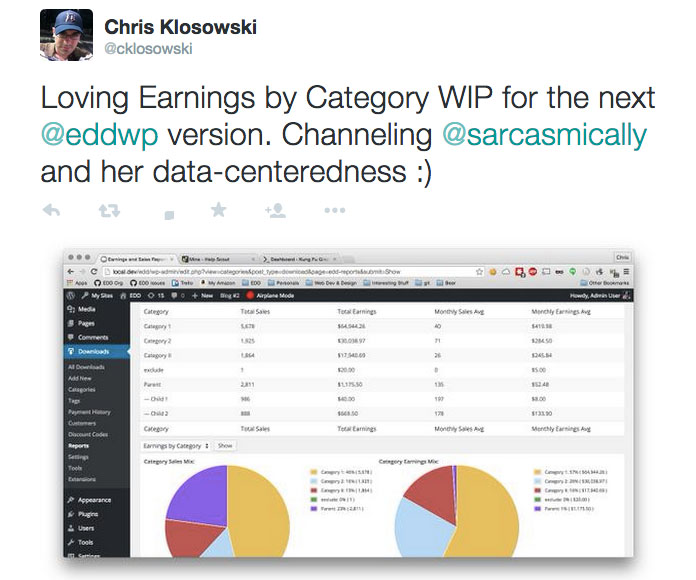Last week I (Brianna) had the pleasure of gathering five developers and talking about ways to improve the reporting capabilities in e-commerce software.
I think it’s wonderful that the lead developers on products like Easy Digital Downloads and WP E-Commerce care about what is usually considered a mundane feature that takes a backseat to more flashy requests. A very important but oft-overlooked part of a successful business is regular analysis of different facets of your product, your customers, and the transaction itself.

Here are some examples of reports any product business should care about:
- Product mix – for sales, renewals, and upgrades
- Sales behavior over time period
- Refund rate
- Discount usage
- Payment gateway mix
- Repeat customers
- Customer segmentation based on time of purchase
- Customers who own product A and product B (or any combo of products)
Businesses specifically in the digital product space might also be interested in:
- Renewal rate
- Upgrade rate
- Affiliate sales as percent of total
Businesses working in the physical product space would also probably care a lot about things like:
- Shipping provider mix
- Sales by location
This is a good start. Not to get too 90’s R&B on you, but if you can dream it, you can do it. (Or should be able to!) Imagine the insight at your fingertips when you combine product reports, site analytics, and finance reports!
Helping people make better business decisions starts with giving them the tools to do so.
For the e-commerce/product management software developers in the audience…
Start small
The best and most frustrating thing about most e-commerce software is that it’s probably already tracking all the data that would make those reports doable, but not providing the user a way to see or extract it. Making it easy for managers to get reports is the most reliable way to get people to pay attention to the data, and paying attention to the data is key to building better businesses.
If I know you developers reading this– and I do– you’re probably thinking of some grandiose way to display all this sexy, sexy data on a gorgeous dashboard chart. I admire your vision, but at bare minimum let’s get the data stored and exportable. Us analysts are really just looking for an excuse to mess with spreadsheets anyway.
Always be collecting
ABC, baby. Always. Be. Collecting. Collect data at every single point of a transaction. There is no such thing as too much data. Believe in Bigfoot before you believe that there can be too much data.
Better data storage
For any data point that may be used for sorting (via query, export, etc), it’s critical to store data in key values instead of arrays. We want individual meta keys; an array of data that gets stored in a serialized format sucks for reporting.
Additionally, store consistent data. For example, if you store numerical items, but a possible piece of data is “zero” – store the zero as a numerical item as well, instead of not storing anything or storing the word “none”.
A better product landscape helps everyone. Let’s put some focus on improving reporting capabilities in e-commerce software to start educating product companies on focused, valuable analysis of their business.
—
I polled Nathan Peretic at Cotton Bureau and Jessica Commins at Copyblogger to get additional insight on reports that product companies would find useful, so props to them for expanding the discussion from solely my own experiences in digital product management.




